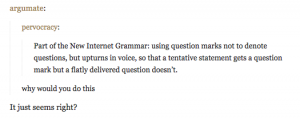The Internet of Punctuation: New uses of the question mark and exclamation point
Public Relations is constantly in a game of cat-and-mouse with public uses of language and how to communicate authoritatively but still in an engaging fashion. Language is in a perpetual state of flux, but its rate of change has been dramatically accelerated by the internet. Recently, the below post started circulating around the blogging platform tumblr:

And it’s true. Aloud, if one asks a flat, sarcastic, or rhetorical question, one may not raise their voice towards the end of the question, but if one is making an uncertain statement, expressing doubt about the veracity of a statement, or conveying a lack of confidence, one may tone the end of the statement to mimic a question. Consider the following:
Is this even real.
I’m just not sure if I like it?
Why would you do this. I don’t deserve this?
While canonically incorrect, the reader knows exactly how to read these statements. “Flat questions” and “tepid statements” bring to light how increased text communication calls for more precisely marked sentences. Especially in marketing, advertising, and blogging, it’s important to keep subtle changes such as these in mind to ensure what you write and what your reader sees are the same thing.
Just as the question mark has undergone a dramatic re-brand, so has the exclamation point, commonly called the “screamer” for syllable economy. Tony Farrington, professor of writing at Indiana University of Pennsylvania, was once quoted as saying, “In your whole life, you get three exclamation points. Use them wisely.” Made in reference to lazy writers, Farrington wanted students to eschew the crutch of exclamation points in favor of more vibrant writing including stronger verbs and a faster pace. Renowned writing blog Grammarly similarly warns against screamers except in the case of severe emergency and highly unusual excitement.
However, come the dawn of twitter, character economy was the name of the game, and beautiful verbs take up way more space than a screamer or two…or three or four. And no one mastered this quite like US president-elect Donald Trump. According to a FiveThirtyEight analysis of all his tweets, Donald Trump uses at least one exclamation point in over two thirds of his tweets with no real way to distinguish between between a happy usage (about, say, a new policy) or an accusatory usage (to attack an opponent). The overuse of the screamer has been its demise, as many outlets including Vogue have declared it “dead.” It’s now just a Trump thing.
Twitter was also the catalyst that completely changed the trajectory of the octothorpe, a.k.a. the pound sign, a.k.a. the hashtag. Detailed well on an episode of 99% Invisible, the symbol has seen numerous uses as the needs of the time dictated. Originally, it dates back to ancient Rome, where the abbreviation “lb” written hastily morphed into the # we all know today, according to Keith Houston, author of Shady Characters, a history of various typographical symbols. Then, when rotary phones became a household item, the symbol re-adapted to the needs of phone numbers. In its most recent iteration, Chris Messina used the symbol to classify all tweets about an event he was attending called Bar Camp. Twitter picked up on the idea of the hashtag as a search term for events, unfolding current events, and the like.
As the language and the internet continue to grow, so will punctuation and the way we use it to classify information and express the emotions we want flat text to evoke. In marketing, advertising, blogging, or anything that requires you to communicate feeling in nothing but words, be confident breaking the rules. The ultimate rule of grammar, despite the warnings of grammar teachers, goes, “If it sounds better when you break the rule, break it.”

